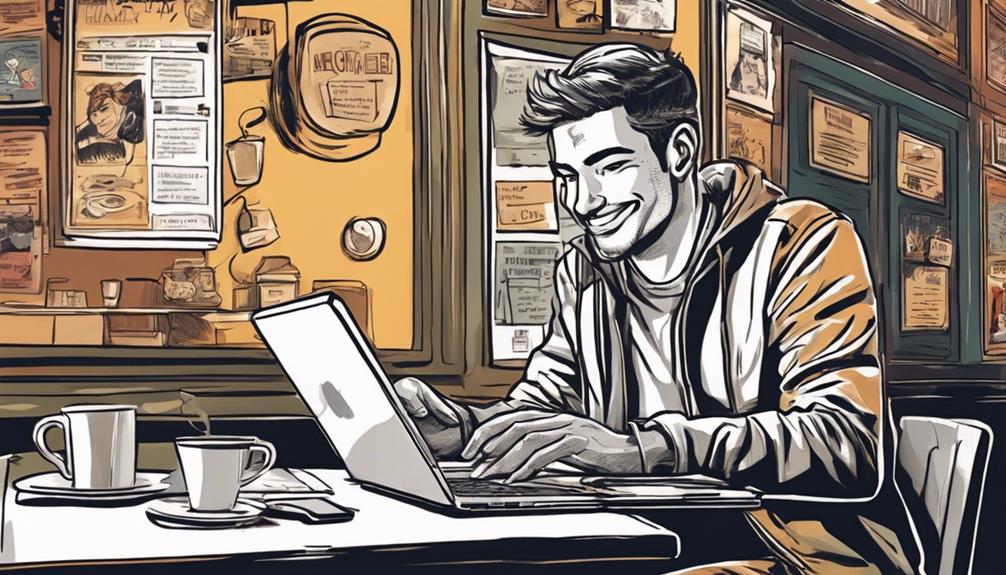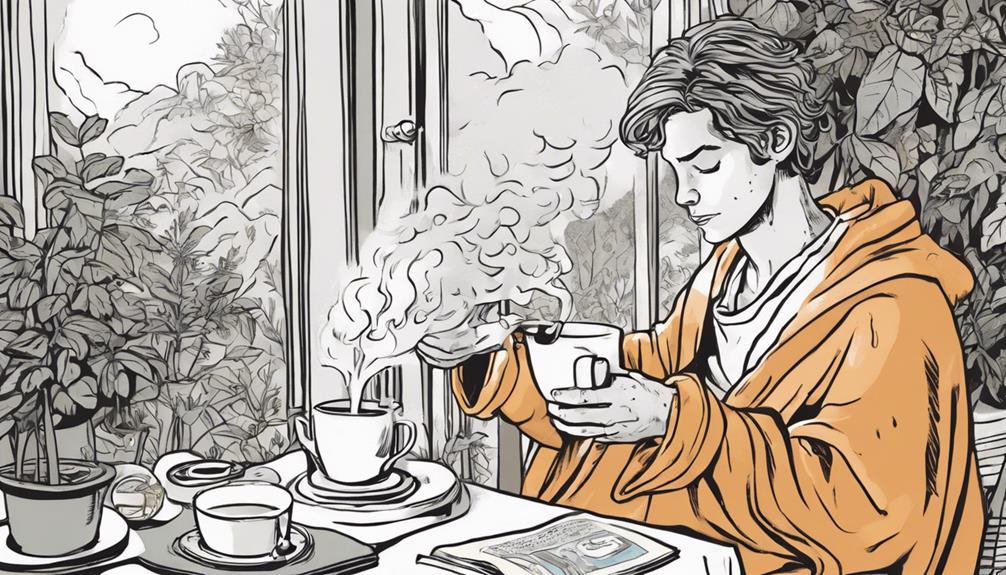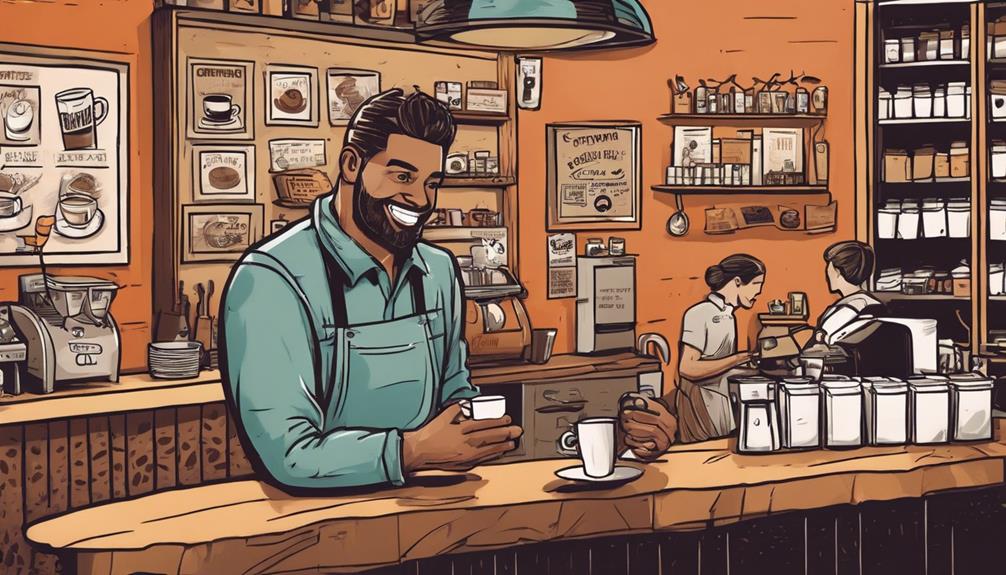When inviting someone to coffee, it is important to send a friendly and brief email outlining your intentions clearly. Suggest convenient locations for the meeting and inquire about their availability. Show sincere interest in getting to know them on a personal level. Be welcoming and open to adjusting plans as needed. This method sets the foundation for a successful interaction.
Key Takeaways
- Clearly state your intention to meet for coffee in a friendly manner.
- Propose a specific time and place for the meetup to streamline planning.
- Express genuine interest in getting to know the person better.
- Keep the invitation open-ended to accommodate different schedules.
- Use casual and welcoming language to make the person feel comfortable.
Benefits of Coffee Meetings
Engaging in coffee meetings cultivates stronger relationships and facilitates open communication in a casual setting. These meetings provide an ideal environment for building personal connections and trust with clients or colleagues.
By initiating a coffee meeting, you showcase a genuine interest in getting to know the other party on a more personal level. The relaxed setting that coffee meetings offer encourages more open and honest discussions, which can enhance business relationships by creating a comfortable atmosphere for both parties involved.
Moreover, these informal gatherings present a quick and straightforward way to connect and expand your professional network.
Ways to Ask for Coffee

When requesting a coffee meeting, consider utilizing a professional email template to clearly communicate your intentions and suggest a convenient location for both parties to meet. Crafting a well-written email can help avoid confusion and set the tone for a successful meetup.
Clearly state your purpose for the coffee meeting, whether it's to discuss a potential collaboration, catch up on industry trends, or simply get to know each other better.
In your email, propose a few possible meeting places that are easily accessible for both parties. This shows thoughtfulness and flexibility on your part. Additionally, inquire about the other person's preferred timing to guarantee the meeting works well for them too.
Remember, the goal is to make the invitation as inviting and accommodating as possible.
When asking someone for coffee, keep your email concise, friendly, and to the point. Sign off with a warm closing and leave the door open for them to suggest any changes in plans if needed.
Effective Email Requests

Crafting clear and specific email requests is essential to effectively communicating your intentions and scheduling coffee meetings with potential contacts. When sending a follow-up email to ask for a coffee meetup, ensure your message is concise and limited to two paragraphs.
Express your interest in meeting up and mention something positive about your previous interaction to strike a balance between networking and appreciation. Remember to wait at least a month after an interview before proposing a coffee meeting to avoid appearing overly enthusiastic. Be specific in suggesting a timeframe for the meetup, making it easier for the recipient to agree to a schedule.
If you receive a decline or no response, respect their decision and avoid sending multiple follow-up emails. By following these tips, you can increase the chances of successfully arranging a coffee meeting with your desired contact.
Networking Importance

Networking plays a vital role in career development by facilitating connections that can lead to various opportunities and professional growth. It's important to understand that 85% of jobs are filled through networking, showcasing its importance in the job market.
By actively engaging in networking, you can tap into the hidden job market, where 70-80% of jobs aren't advertised. Building professional relationships through networking isn't just about job hunting; it can greatly impact your job satisfaction and open doors to mentorship opportunities.
Informational interviews conducted during networking events can provide valuable insights into different industries and career paths, helping you make informed decisions about your professional journey. Additionally, networking enhances your visibility in the industry, making you more likely to receive referrals and recommendations, which can further boost your career prospects.
Research Before Connecting

Conducting thorough research before setting up a coffee meetup can greatly boost the quality of your interaction.
When preparing for a meetup with someone over coffee, it's beneficial to utilize social media platforms such as LinkedIn, Twitter, and Instagram to gather insights into their background and interests.
By checking their recent activities, press features, and industry publications, you can gain valuable information that will help steer your conversation in a meaningful direction during the coffee meeting.
Understanding the person's work and accomplishments beforehand enables you to approach discussions more effectively and build a stronger connection.
Researching before connecting isn't just about gathering information; it's about showing genuine interest and respect for the individual, which can significantly enhance the quality and relevance of your coffee meetup interaction.
Professional Communication Tips

When reaching out for a coffee meet-up, make sure your email tone is friendly and professional to create a positive impression.
Be clear and specific about your request, suggesting a particular date and time for the meeting.
Additionally, consider the timing of your proposal, waiting at least a month after an interview to demonstrate respect for the recipient's schedule.
Email Tone Clarity
Maintaining a professional tone in your emails is vital for conveying respect and seriousness in your professional communication.
When reaching out to someone via email, it's important to use clear and concise language to make sure that everyone understands your message.
Ambiguity in your tone can lead to misinterpretation of your intentions, which is why clarity is key to building credibility and professionalism in your email correspondence.
By maintaining a professional email tone, you not only make a positive impression but also establish effective communication with your recipient.
Remember, the way you communicate in your emails reflects your level of professionalism and can greatly impact how your message is perceived.
Request Specificity
Guarantee your communication is precise and detailed when making requests to convey a professional tone effectively. Being specific in your ask will help the other person feel less uncertain and more inclined to agree to your proposal.
Here's how you can confirm your request is clear and to the point:
- Include Specific Details: Provide essential information such as the preferred date, time, and location for the coffee meetup. This specificity demonstrates your commitment and professionalism.
- Use Professional Language: Maintain a formal and respectful tone when making the request. This language choice sets the right impression and shows that you value the recipient's time.
- Avoid Ambiguity: Steer clear of vague or unclear language that could lead to confusion. Being direct and straightforward in your ask will help in achieving a successful outcome and enhancing your professional image.
Timing Consideration
Timing plays an essential role in professional communication, reflecting your consideration for the other person's schedule and availability. When you feel it's the right time to grab a coffee next, think about waiting around a month after a significant professional interaction, such as an interview. This waiting period allows for a natural progression from the initial interaction and indicates that you value the potential meetup.
When proposing a coffee meeting, suggest a specific timeframe to make the request more concrete and actionable. By offering a particular time, you facilitate the scheduling process for both parties, making it easier to plan the meetup. Remember to send your email request once and respect the recipient's decision, whether they accept or decline the invitation.
Being mindful of the timing when asking someone to meet for coffee shows your respect for their time and commitments.
Post-Meeting Etiquette

After meeting for coffee, it's crucial to promptly follow up with a thank-you message to show appreciation for the time and insight shared.
Following these guidelines will help maintain a positive connection and leave a lasting impression:
Express Gratitude and Recap: Send a message expressing appreciation for the meeting and summarizing key points discussed to reinforce understanding and show attentiveness.
Address Queries and Provide Updates: Address any questions that arose during the coffee meetup promptly and provide updates on any actions taken post-meeting to demonstrate commitment and reliability.
Summarize Agreements and Express Interest: Recap any agreements made or action items decided upon during the coffee meeting to ensure alignment. Additionally, express interest in potential future collaborations or discussions to keep the conversation open and foster relationships.
Coffee Invitation Phrases

Recap of the main points discussed during the coffee meeting:
- Different regions have unique coffee invitation phrases.
- Examples include 'grab a cuppa and chat' in Ireland and 'let's meet for a friendly coffee' in the US.
- Polite invitations may include phrases like 'Would you have time for a quick cup of coffee?' or 'Let's meet up for a friendly chat.'
- It's important to be clear with your coffee invitation language.
- Options like 'Let's get together for coffee' are straightforward and friendly.
- Keep cultural nuances in mind when selecting a coffee invitation phrase to ensure it's well-received and understood.
Now, why not invite someone for a cup of coffee with a warm and friendly approach? How about saying, 'Would you like to grab a cup of coffee and catch up sometime this week?' This inviting phrase can set the stage for a pleasant and relaxed coffee meetup.
Casual Coffee Invitations

When inviting someone for a casual coffee meetup, consider using relaxed language like 'Let's grab a coffee' to create a welcoming atmosphere. This approach can help the person feel more comfortable and open to the idea of meeting up.
To further enhance the casual vibe of your invitation, you can suggest a specific timeframe such as 'How about we meet for coffee this weekend?' This not only streamlines the planning process but also shows that you're genuinely interested in meeting up.
Additionally, keeping the invitation open-ended by proposing a time in the next few weeks can accommodate different schedules, making it easier for the other person to find a suitable time.
Frequently Asked Questions
How Do You Ask Someone to Meet for Coffee?
To ask someone to meet for coffee, keep it simple and direct. Suggest a specific day, time, and location. Express your interest in meeting and discussing shared interests. Follow up with a polite reminder if needed. Hey there! I would love to meet up for coffee and chat about our mutual interest in photography. How about we meet at the local café on Saturday at 10 am? I’m really looking forward to catching up and sharing ideas. Let me know if that works for you.
I’ve been thinking about how to initiate a coffee chat and would love to hear your thoughts on it. Maybe we can come up with some creative ways to connect with other photography enthusiasts over a cup of coffee. Let me know your availability and we can plan it out.
How Do You Politely Invite Someone to Coffee?
When inviting someone to coffee, suggest a specific time and place: "Hey, want to grab coffee at 10 am tomorrow at the cozy cafe downtown?" Keep it friendly and casual to create a relaxed atmosphere.
How to Ask Someone Out for Coffee Platonically?
When asking someone out for coffee platonically, simply suggest a specific time and place for the meetup. Keep the tone light and friendly. Show genuine interest in getting to know them better over a cup of coffee.
How Do You Say Let's Meet for Coffee?
You say, "Let's grab a coffee sometime!" It's casual and friendly. Consider the recipient's culture for better communication. Direct and warm language makes inviting others for coffee more inviting and likely to be accepted.
Conclusion
So next time you want to connect with someone, don't hesitate to ask them for coffee! It's a great way to build relationships and network effectively.
Remember, a simple coffee invitation can lead to fruitful collaborations and opportunities. So go ahead, take the plunge and ask that person out for a cup of joe. Who knows, it might just be the start of something amazing!
Remember, the world is your oyster!









